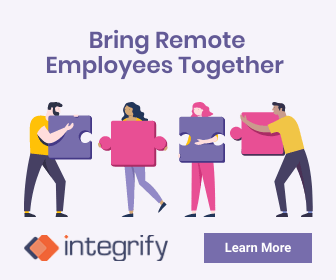
Remote onboarding (or virtual onboarding) has made the process of getting employees up and running (and productive) even harder. But there are ways to make it better for everyone.
Related:
-
Free eBook: Automating the Employee Onboarding Experience
Many companies looking to recruit and onboard new talent have experienced a chilling trifecta since the COVID-19 pandemic: the number of fully remote hires has continued to increase, virtual onboarding is the new norm, and the current resources and onboarding processes in place to handle it are insufficient for new team members.
Creating the right remote onboarding experience for your company is now more critical than ever, especially during the transition time between when a worker is hired and starts working. This period impacts and shapes your company’s employee satisfaction and retention goals like no other.
As the saying goes, you only have one chance to make a good first impression: Employee onboarding is the first impression you’ll have of newly-hired remote workers. It’s their first accurate impression of your company culture—so you can’t afford to blow it!
Remember, the onboarding process sets the tone for the remote employee’s relationship with your company. A disconnected and poorly organized on-ramping experience sends a clear message to new hires: your company may not be committed to their well-being, much less their ongoing growth and nurturing.
Have you ever experienced a poor onboarding experience? Most of us have. How did it make you feel? Lost? Underappreciated? Unprepared? All, most likely. Statistics demonstrate that you or anyone else in this position are probably asking another question, namely, “What have I gotten myself into?”
Some numbers to consider:
-
4% of workers quit following a bad first day (Bersin by Deloitte)
-
22% of employee turnover happens within the first 45 days. (The Wynhurst Group)
-
90% of employees decide if they will stay with the company within the first six months. (Aberdeen Group)
-
31% of people have quit a job within the first six months, half of those coming in the first three months. (BambooHR)
As a company looking to hire remote employees, you can set yourself up for success in two critical ways: properly managing expectations through good communication and using technology efficiently, including workflow automation solutions for employee onboarding to ensure a smooth process.
Properly Manage Employee Expectations
Remember when we worked in offices and could lean over and ask our colleagues a question? As a new employee in an office setting, if I was unclear about a particular assignment or work requirement, I could trot down the hall to my supervisor and clear things up. Now that we’re all doing more remote work, these spontaneous drop-ins are no longer possible, making a proactive communication plan essential—not only about what’s expected of them in their new role, the time they’ll have to complete required training, and how provisional and appraisal periods will be conducted, but also how they can be made to feel a part of the culture even while away from the office:
-
Discuss manager availability and plan regularly- and frequently scheduled one-on-ones to support new hires during their transition period. This could be via video calls, audio calls, or instant messaging.
-
Provide a well-rounded list of coworkers and trusted influencers with whom new hires can conduct 15-minute introductory meetings remotely. This will help them begin to build their internal networks and understand the impact of their role on others.
-
Provide a mentor or small group of reliable coworkers who can answer questions, provide guidance, and help facilitate the acculturation process.
-
Provide a clear outline of what the new hire is expected to accomplish in the first 30, 60, and 90 days. Check-in frequently on their progress to provide any support needed.
Use Technology Efficiently
You’ve heard this before. But what exactly does it mean in the unique and challenging environment of remote onboarding? Firstly, new hires need to master the communication tools they’ll use to stay connected and productive. This includes not just phones and email, but group messaging tools like Microsoft Teams and Skype for Business, and video-conferencing on these platforms and others such as Zoom and Go-To Meetings, since this will likely be their primary way of communicating and staying in touch remotely. Make sure they’re well acquainted with the software applications they’ll need to use, from content management systems and file-sharing platforms like Tesla and Dropbox to collaborative platforms like JIRA, Confluence, and internal social platforms like Yammer, Slack, or the company intranet.
You may also wish to research workflow automation solutions for employee onboarding to ensure a smooth process. For example, automating the request process for onboarding new employees is becoming more affordable and practical. Customized portals and workflows can be built to handle request/information intake (forms) and the subsequent routing of the information around the organization. The portal can be leveraged by the new employee’s manager, the employee themself, or HR, depending on what part of the process they handle.
Requests (hardware, network access, benefit forms, furniture, etc.) that are typically part of the virtual onboarding process can then be initiated online, with IT, Finance, Facilities, and other departments getting notifications and approvals in an automated fashion instead of relying on paperwork, phone calls and back and forth emails/instant messages.
In addition, providing new employees with an online portal gives them a centralized location to track the status of the process and keep up-to-date on when requests will be fulfilled. This type of request portal becomes their window into the company and promotes consistency and stability as they acclimate to their new company.
Potential onboarding processes to automate include:
Pre-hire
-
Position request form
-
Recruitment and application process
-
Internal referrals
-
Interview feedback and tracking
-
Offer ttracking
-
Background checks
-
Security badge request
-
Business card ordering
During Hire
-
New hire information gathering
-
IT Setup form (hardware, software, network access)
-
Policy/mission review and acknowledgment.
Post-Hire
-
A survey of their onboarding process
-
Employee information change
-
Personnel action
-
Hardware and software requests
-
Leave requests
-
Expense and travel requests
-
Performance reviews and acknowledgment
-
Goals tracking
-
Peer and team recognition and awards
Turn remote onboarding from liability to strength by optimizing and automating the process with workflow automation. We can help you streamline your new employee process by using Nutrient Workflow to manage your entire workflow. Learn more with a live, customized demonstration.

Mike Raia
Marketing the world’s best workflow automation software and drinking way too much coffee. Connect with me on LinkedIn at https://www.linkedin.com/in/michaelraia/





